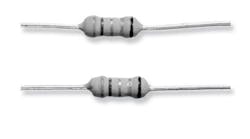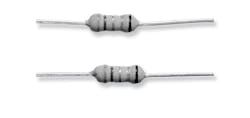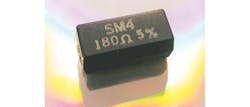Find a downloadable version of this story in pdf format at the end of the story.
Fusible resistors typically utilize one of two technology types: film resistor technology or wirewound technology. Fusible film resistors are useful for lower power requirements and applications where the overload and surge handling requirements are not too severe. However, many power supply and control circuits need a more robust resistor that can withstand higher power, higher short-term pulses and higher temperatures. For all of these requirements, the fusible wirewound resistor is a better choice. Fusible wirewound technology can be used to tailor the fusing performance characteristic to match the design guidelines of many different end products and markets.
Fusible film resistor technology starts with a standard film resistor design. It will typically use the same resistor film alloy and materials as a basis for a fusible part (Fig. 1).
For a reliable and repeatable fusing characteristic, the sputtered film thickness and composition must be more carefully monitored to ensure uniformity across the manufacturing lot. After the filming process, the calibration step is the most critical. It is this process that controls the fusing action of the part along with dictating the exact resistance value. The more calibration trimming, the shorter the fusing time or the lower the power needed to fuse a given size and resistance value. However, the resistance value of a given manufacturing lot will vary more widely when the calibration trim is used to control fusing time. This variation in resistance value can also cause variation in fusing performance since higher resistance values will fuse quicker for a given current load. Many fusible resistors therefore are only offered in 5% absolute resistance tolerances and higher. Typical fusing characteristics for fusible film resistors are stated as fusing time (typically fuses in less than 30 seconds, 15 seconds, 5 seconds, etc.) at a specified magnification of power such as 10X, 15X, or 25X. Fusible film resistors are used in various low power and low surge applications. These include low level fire safety, monitoring and management, high-end audio / video systems, environmental management controls and systems, and laser printers.
FUSIBLE WIREWOUND RESISTORS
A typical fusible wirewound application will require the fusing resistor to pass some type of short transient event without failing. The appliance and white goods industry, electric power tools, utility meters, communications equipment, fire safety equipment, and HVAC systems all have requirements of this type. An example is a fusible wirewound that must pass hundreds of 20 microsecond pulses of 6000 volts without failure, but must fuse quickly and without flames when subjected to 120-V short circuit overloads. While it is relatively easy to build a wirewound resistor that can withstand the 6KV surges, it is much more difficult to maintain that while also having a fusing characteristic that opens without flame or excess heat generation. Many component manufacturers create the fusing action of the wirewound by simply making one of the two welds of the element to the end-cap weaker. While this does create a failsafe characteristic, the repeatability for this fuse design is less than desirable. In some cases, the part will fuse under normal circuit conditions, and in others the part will not fuse until the PCB is charred or has caught on fire. This is clearly unacceptable for a resistor residing in a dishwasher, clothes washer, refrigerator or smoke detector. The more advanced fusible wirewound technology utilizes material properties of the resistance wire alloy, core size and shape, lead wire and heat management. Another factor that can affect the performance of a fusible wirewound resistor is the trimming process. Any significant amount of trimming will reduce the effective current carrying capacity of the wire element. In some cases, the wire cross section can be reduced by as much as 40%. The trim process generally doesn't dramatically decrease the steady state power handling of the wirewound resistor, but it will have a dramatic effect on the surge handling of the device. For example, a 5-watt low resistance value wirewound designed for pulse withstanding with minimal or no calibration trim may be able to handle around 70 Joules of energy, while a standard commercial wirewound would only be guaranteed to handle 0.4 Joules.
Fusible wirewound resistors (Fig. 2), depending on the individual customer requirements, do not have the price premium that is usually expected of a device that is used as part of a circuit protection scheme. While the limits and restrictions on materials and trimming do increase manufacturing costs, the overall benefit of the failsafe performance outweighs any nominal price increase. In some cases, fusible resistor applications can be in very high volume and the fusible wirewounds can provide a very economical solution that is friendly to mass production yet provides a reliable and repeatable fusing response.
DESIGN ADVANTAGES
Many power supply design engineers can replace a wirewound resistor and separate fuse with a single failsafe wirewound (Fig. 3).
UL has recently put a new focus on the resistor and fuse used in motor control and protection applications, with the objective to only use a single device. A single part will be more reliable and repeatable than two separate and independent components and will typically be less expensive. There are also applications that require or prefer a thermal fuse within the same package as the wirewound resistor. While the use of the thermal fuse lowers the effective power handling of the resistor, it does provide a very distinct fusing action that is guaranteed to protect the circuit if a certain temperature level is exceeded. These types of thermal fuse protected wirewounds are also slightly more expensive than a comparable fusible wirewound of the same size, but certain applications and end products demand the more thorough characterization that the thermal fuse provides.
As indicated, one of the advantages to wirewound resistors is also one of its drawbacks for some applications; it is a very robust resistor technology. While this is very good for applications where no significant overload is possible on a continuous basis, it presents a problem for applications that do have the potential for over power conditions. The wirewound resistor will continue to heat up until it has destroyed itself and anything unlucky enough to be near it. With careful consideration of materials along with tightly controlled manufacturing processes, a device that fails safely yet withstands short surges of 6KV or more can be produced without dramatically increasing the cost of the device.
For applications that require a robust solution, fusible wirewounds provide a more repeatable and predictable fusing characteristic. Able to withstand thousands of short high power surges, fusible wirewounds are more cost- effective than a two-part solution combining a standard wirewound resistor and a fuse.
-
Withstand thousands of short high power surges, fusible wirewounds are more
-
cost effective than a two part solution comprised of a standard wirewound
-
resistor and a fuse in combination.
Download the story in pdf format here.



